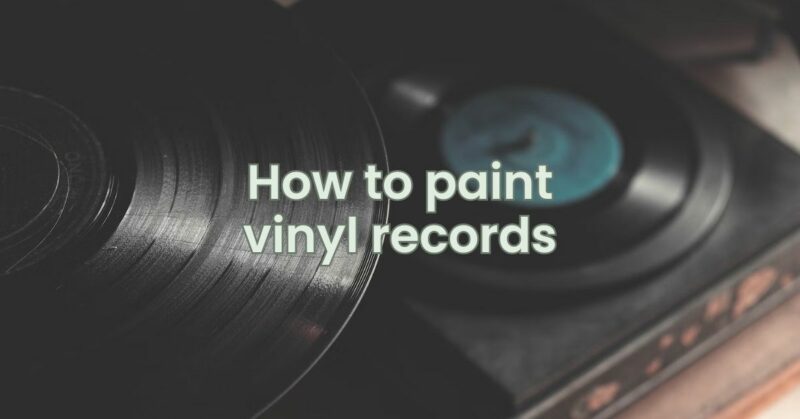Vinyl records have not only stood the test of time as a medium for music but have also become a canvas for artistic expression. Painting on vinyl records allows artists and DIY enthusiasts to combine their love for music and creativity to create unique and eye-catching pieces of art. If you’re eager to explore the world of vinyl art and want to know how to paint vinyl records, this step-by-step guide will take you through the process of creating stunning vinyl artwork.
Materials Needed:
- Vinyl records: Choose records that you are willing to transform into art pieces. Ensure they are clean and free from dust or dirt.
- Acrylic paint: Opt for high-quality acrylic paint in a variety of colors to suit your artistic vision.
- Paintbrushes: Select a range of paintbrushes in different sizes to accommodate various painting techniques.
- Acrylic gesso primer (optional): If you prefer to prepare the surface for better paint adhesion, consider using acrylic gesso primer.
- Palette or mixing tray: Use to mix and blend paint colors as needed.
- Easel or flat surface: Provide a stable and comfortable working area for your painting process.
- Protective covering: Lay down a drop cloth or protective covering to keep your workspace clean.
- Acrylic varnish (optional): Consider using acrylic varnish to protect and preserve the finished artwork.
Step-by-Step Guide:
- Clean the Vinyl Record:
Before starting your vinyl art project, clean the record thoroughly using a mild detergent and water to remove any dirt or oils. Rinse and dry the record completely before painting.
- Set Up Your Workspace:
Choose a well-ventilated area with adequate lighting to set up your workspace. Lay down a drop cloth or protective covering to prevent any accidental spills on your work surface.
- Prepare the Vinyl Record (optional):
If you wish to enhance paint adhesion, you can apply a thin coat of acrylic gesso primer to the vinyl record. Gesso is designed to promote better paint adhesion on non-porous surfaces like vinyl. Allow the primer to dry according to the manufacturer’s instructions before proceeding.
- Plan Your Design:
Consider the artistic vision you want to achieve and plan your design before you start painting. You can sketch your ideas on paper or directly on the record’s surface using a pencil.
- Choose Your Paint Colors:
Select the acrylic paint colors that best suit your design. Place small amounts of each color on your palette or mixing tray for easy access during the painting process.
- Start Painting:
Begin painting on the vinyl record, using your sketch or design as a guide. You can use various painting techniques such as brush strokes, splattering, or even using stencils for more intricate details. Allow the paint to dry between layers if you plan to apply multiple coats.
- Add Details:
Once the base layer of paint is dry, you can add finer details and highlights to your artwork. Use smaller paintbrushes to achieve precision in your design.
- Allow for Proper Drying:
Allow your artwork to dry completely before handling or making any final touches. Patience during the drying process ensures that your artwork remains intact.
- Optional Varnishing:
If you wish to protect your finished artwork and enhance its longevity, consider applying a clear acrylic varnish. The varnish provides a protective layer that shields the paint and vinyl from damage and dust.
- Display Your Vinyl Art:
Once your artwork is completely dry and, if applicable, varnished, you can display it proudly in your living space or create a gallery wall featuring multiple painted vinyl records.
Conclusion:
Painting on vinyl records is a delightful and creative way to express yourself and combine your love for music with art. By following this step-by-step guide, you can create stunning vinyl artwork that showcases your creativity and adds a unique touch to your home decor. Remember to experiment with different techniques, colors, and styles to truly make each vinyl art piece your own. Whether you’re an experienced artist or a novice exploring vinyl art for the first time, painting on vinyl records allows you to transform music into visual art in an exciting and innovative way.

